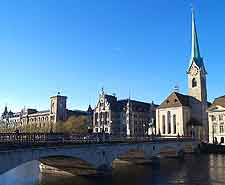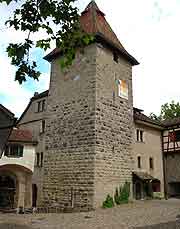Zurich History Facts and Timeline
(Zurich, Switzerland)

People have been drawn to the Zurich area for many thousands of years in history. Evidence of settlements from the Neolithic period of the Stone Age, as well as the Bronze Age, has been unearthed as various points around Lake Zurich.
In more recent times, the Celtics and Romans chose to settle around the Lindenhof Hill area, and this district still remains today, forming the very heart of the historical Altstadt (Old Town). The settlement was named 'Turicum' and this became a place where taxes were collected, whilst the Limmat River provided transport connections for trading.
A New Settlement
Although the Romans remained here for more than four centuries, when their empire fell, it was not long until major changes were afoot. The Germanic Alamanni peoples soon set up home here, making use of the former Roman fortifications and enjoying the organised infrastructure and buildings that had been left behind. A new Carolingian fortress was built in the 7th century, followed by the Fraumunster Abbey in the year of 853 AD. Although the abbey / convent was dissolved in the 16th century, its centrepiece Fraumunster Church is still standing as a reminder of this period in Zurich history.
King Henry III, a Holy Roman Emperor, took an interest in the town in the 11th century and granted it the right to host regular markets. Zurich also began to collect some tolls and a mint was soon built. In 1218, Zurich became an Imperial City and its status was somewhat catapulted into new heights. The 1230s saw the city construct a defensive wall and a number of stone houses were erected along the street named the Rennweg, with the old fortress ruins being used as a convenient source of building materials.
A Period of Independence
With the power of the convent now noticeably waning in the 13th century, Zurich locals elected their very first independent mayor. In the middle of the 14th century, the city joined the Swiss Confederacy and assumed an important role.
The Old Zurich War marked a period of dissent between the city and the surrounding cantons, lasting from 1440, right up until 1446, when peace was finally agreed upon. In the 1520s, the Protestant Reformation sweeping through Switzerland was joined by Zurich, and various battles between the Protestant and Catholic cities took place. These included both the First War of Kappel in 1529 and the Second War of Kappel in 1531.

Further Fortifications
During the 1620s and shortly after the start of the Thirty Years' War, Zurich felt it necessary to improve its defences and a new fortified wall soon encircled the city. These fortifications were costly, although made the city quite impenetrable. Feeling rather pleased with its newfound grandeur, Zurich declared that it was now a republic and ditched its former title of Imperial City.
The 1798 Helvetic Republic made itself known, being implemented in an attempt to unite the country with a central power, thus eliminating the need for self-governing cantons. As a result of this policy, Zurich's power fell virtually overnight and it lost not only its control over the surrounding land, but also many of its privileges. The majority of its fortifications were subsequently demolished, while its university was founded from existing colleges in 1833, and the city briefly served as the Federal capital between 1839 and 1840.
After the Swiss Federal State was formed in 1848, Zurich's numbers soon began to swell, as migrants arrived from the countryside. The city struggled to cope with this rapid population increase and many of these immigrants were treated as second-class citizens, that was unless they had money. The industrial revolution fortunately came along and created mass employment for many of these new residents. New streets were laid out, and in 1877 the Zurich Stock Exchange (now the SIX Swiss Exchange) was born. In 1893, many outlying suburbs were incorporated with the city and its boundaries grew.
Damage in World War II
When the First World War came along, Switzerland chose to adopt neutrality, and this was the case again during the Second World War. However, its stance proved to alienate a number of European countries, with Zurich and a few other cities suffering damage from bombing, although the worst attacks were said to be accidental, when US bombers mistook Zurich for the German city of Freiburg im Breisgau.
Tourism and Finance
Zurich is undisputed as being one of the most important financial cities on the planet. Many leading banks and financial institutions have chosen to base themselves here, or at least have some kind of a presence in this wealthy city.
Tourism is also playing a part of the local economy and recent surveys showed that the city offers an exceptionally high quality of life. Visitors will find tasters of Swiss medieval history around many corners of central Zurich, particularly within the Niederdor and Oberdorf districts. The lake promenade, the bustling Bahnhofstrasse shopping street and the city's historical Zoological Gardens should all be experienced. The Museumstrasse is rich in culture and this is where you will find the Swiss National Museum (Schweizerisches Landesmuseum), the country's largest history museum.
 People have been drawn to the Zurich area for many thousands of years in history. Evidence of settlements from the Neolithic period of the Stone Age, as well as the Bronze Age, has been unearthed as various points around Lake Zurich.
People have been drawn to the Zurich area for many thousands of years in history. Evidence of settlements from the Neolithic period of the Stone Age, as well as the Bronze Age, has been unearthed as various points around Lake Zurich.